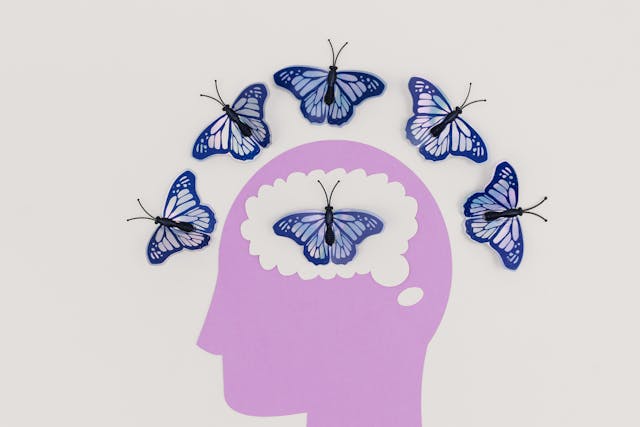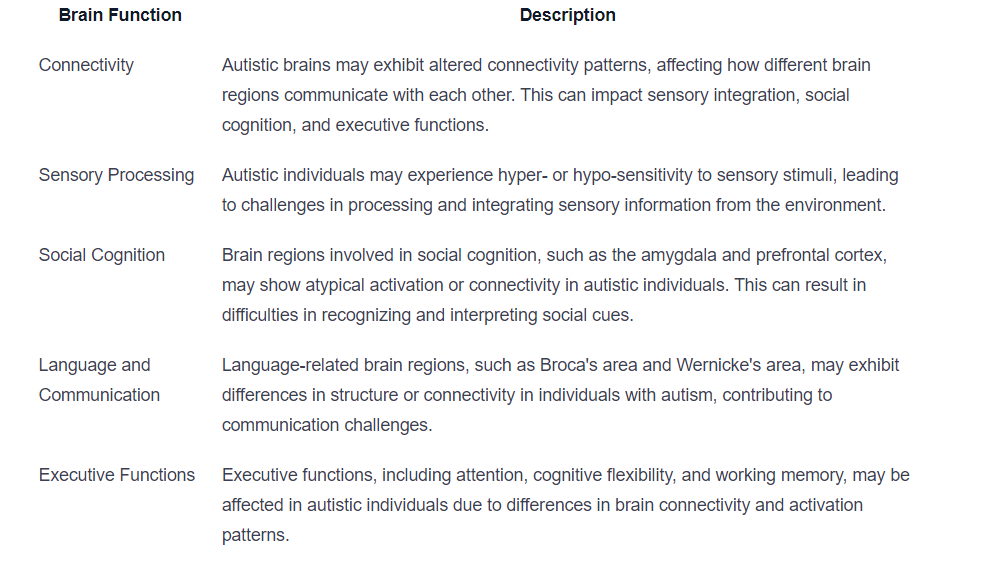How Do Autistic Brains Work?
Unveiling the mysteries of autistic brains. Delve into the unique traits and cognitive processes of autism today.

Understanding Autism
Autism is a complex neurodevelopmental disorder that affects social interaction, communication, and behavior. It is characterized by a wide range of traits and characteristics that can vary from person to person. By delving into what autism is and exploring the common traits and characteristics associated with it, we can gain a better understanding of how autistic brains work.

What is Autism?
Autism, also known as Autism Spectrum Disorder (ASD), is a lifelong condition that typically becomes apparent during early childhood. It affects individuals across all races, ethnicities, and socioeconomic backgrounds. Autism is characterized by difficulties in social interaction, communication, and the presence of repetitive behaviors or restricted interests.
While the exact cause of autism is still unknown, research suggests that a combination of genetic and environmental factors may contribute to its development. It is important to note that autism is not caused by any specific parenting style or external factors.
Common Traits and Characteristics of Autism
Autism manifests differently in each individual, but there are several common traits and characteristics that are often associated with the disorder. These include:
Traits and Characteristics
Challenges in social interaction and communication
Difficulty understanding and responding to non-verbal cues, such as facial expressions and body language
Preference for routine and resistance to change
Sensory sensitivities or differences, such as being hypersensitive or hyposensitive to certain sounds, textures, or lights
Engaging in repetitive behaviors or having intense, specific interests
Difficulty with abstract thinking and understanding social norms
Variability in cognitive abilities, ranging from intellectual disabilities to exceptional talents in specific areas
It is important to recognize that every individual with autism is unique and may exhibit these traits to varying degrees. Some individuals may require more support and accommodations, while others may have strengths in certain areas that should be nurtured and celebrated.
By understanding what autism is and being aware of the common traits and characteristics associated with it, we can foster a more inclusive and accepting society. It is crucial to provide support and accommodations that cater to the specific needs of individuals with autism, allowing them to thrive and reach their full potential.
Brain Function in Autism
Understanding how autistic brains work is a complex and ongoing area of research. The neurodiversity perspective recognizes that autistic individuals have unique neurological differences that contribute to their diverse strengths and challenges. In this section, we will explore the concept of neurodiversity and highlight key differences in brain function associated with autism.
Neurodiversity and the Autistic Brain
Neurodiversity is a concept that emphasizes the natural variation in human brains and the acceptance of different neurological conditions, including autism. It recognizes that autistic individuals have valuable perspectives and abilities that should be respected and celebrated.
The autistic brain exhibits distinct patterns of neural connectivity and information processing. These differences can lead to variations in sensory perception, social interaction, communication, and cognitive processing. It's important to approach autism from a neurodiversity perspective, recognizing that these differences are not deficiencies but rather unique manifestations of human diversity.
Key Differences in Brain Function
Research has revealed several key differences in brain function between autistic and neurotypical individuals. These differences contribute to the traits and characteristics associated with autism. While the specific mechanisms are still being studied, here are some notable findings:

It's important to note that these differences in brain function are not universal among all autistic individuals. The spectrum nature of autism means that each person's brain function may vary, leading to a wide range of abilities and challenges.
By understanding the neurodiversity perspective and the key differences in brain function associated with autism, we can foster a more inclusive and supportive environment for individuals on the autism spectrum. Embracing and accommodating these differences can help promote acceptance, understanding, and empowerment for autistic individuals.
Sensory Processing
Individuals with autism often experience challenges with sensory processing, which can significantly impact their daily lives. Sensory processing refers to how the brain receives, interprets, and responds to sensory information from the environment. Autistic individuals may have differences in how they perceive and respond to sensory input, leading to sensory sensitivities or sensory-seeking behaviors.
Challenges with Sensory Processing
Autistic individuals may experience sensory sensitivities, where certain sensory stimuli are perceived as overwhelming or distressing. These sensitivities can vary from person to person but commonly involve:
- Hypersensitivity: Heightened sensitivity to sensory input. For example, sounds that may be tolerable to others can be overwhelming for someone with sensory hypersensitivity.
- Hyposensitivity: Reduced sensitivity to sensory input. This can lead to seeking out intense sensory experiences, such as seeking deep pressure or engaging in repetitive behaviors like rocking or hand-flapping.
Sensory sensitivities can affect various senses, including:

Impact on Daily Life
The challenges in sensory processing can have a significant impact on the daily lives of individuals with autism. These impacts can vary depending on the specific sensory sensitivities and the individual's coping strategies. Some common impacts may include:
- Social Interactions: Sensory sensitivities can make it challenging to engage in social interactions, as certain environments or stimuli may be overwhelming or uncomfortable. This can lead to difficulties in participating in group activities or crowded spaces.
- Daily Routines: Sensory sensitivities can disrupt daily routines, such as difficulty with personal care activities like brushing teeth or wearing specific clothing due to tactile sensitivities.
- Emotional Regulation: Overwhelming sensory experiences can trigger emotional responses, leading to anxiety, meltdowns, or withdrawal from the environment.
- Academic Performance: Sensory sensitivities can affect concentration and attention in educational settings, impacting learning and academic performance.
Understanding and addressing sensory processing challenges is crucial in supporting individuals with autism. By providing appropriate accommodations and creating sensory-friendly environments, it is possible to help autistic individuals navigate their daily lives more comfortably and effectively.
Social and Communication Differences
Autism is characterized by distinct social and communication differences that set it apart from neurotypical individuals. Understanding these differences can help foster a more inclusive and supportive environment for individuals on the autism spectrum.
Difficulties in Social Interactions
One of the hallmark traits of autism is the difficulty in social interactions. Autistic individuals may struggle with understanding social cues, nonverbal communication, and the unspoken rules and expectations of social situations. This can lead to challenges in initiating and maintaining conversations, interpreting facial expressions and body language, and understanding social hierarchies.
To illustrate the social differences experienced by individuals with autism, here are a few key areas of difficulty:
Social Interaction Challenges
Difficulty making eye contact
Struggles with understanding personal space boundaries
Challenges in recognizing and interpreting facial expressions
Difficulty understanding and responding appropriately to social cues
Tendency to engage in repetitive or rigid behaviors during social interactions
These challenges can make it harder for individuals with autism to form and maintain relationships, leading to feelings of isolation and exclusion. However, it's important to note that social difficulties can vary widely among individuals on the autism spectrum, as autism is a spectrum disorder.
Communication Variances
Communication differences are another significant aspect of autism. Autistic individuals may experience challenges in both verbal and nonverbal communication. These differences can manifest in various ways, including:
Communication Variances
Delayed or atypical speech development
Difficulty understanding and using non-literal language, such as idioms or sarcasm
Tendency to take language literally
Repetitive or stereotyped speech patterns
Preference for specific topics or interests
It's worth noting that while some individuals with autism may have difficulties with verbal communication, others may excel in certain areas, such as memorization or specialized vocabulary. Augmentative and alternative communication (AAC) systems, including sign language or visual aids, can also be beneficial for individuals with limited verbal communication skills.
Understanding the social and communication differences associated with autism is essential for creating inclusive and supportive environments. By embracing the unique perspectives and strengths of individuals on the autism spectrum, we can foster meaningful connections and promote acceptance and understanding.
Cognitive Processing
Cognitive processing in individuals with autism is characterized by both strengths and challenges. Understanding these aspects can provide valuable insights into how autistic brains work and how individuals with autism navigate the world.
Strengths and Challenges in Cognitive Processing
Autism is often associated with unique cognitive strengths and challenges. While every individual is different, there are some common patterns observed in cognitive processing among people with autism.

Cognitive Flexibility and Autistic Thinking
Cognitive flexibility refers to the ability to adapt and switch between different tasks, ideas, or perspectives. It plays a significant role in problem-solving, creativity, and social interactions. Autistic thinking is often characterized by a preference for consistency, routine, and a focus on specific interests.
Autistic individuals may have a distinct thinking style that is often described as detail-oriented, concrete, and rule-based. This cognitive style can contribute to strengths in specific areas of expertise and a deep understanding of subjects of interest. However, it may also result in difficulties with abstract thinking, generalization, and adapting to changes.
It's essential to recognize and respect the cognitive strengths and challenges of individuals with autism. By understanding their unique thinking patterns and providing appropriate support, we can create environments that nurture their strengths and help them navigate the challenges they may encounter.
In the next section, we will explore how embracing neurodiversity and providing support and accommodations can contribute to a more inclusive society for individuals with autism.
Support and Understanding
Support and understanding play a crucial role in creating an inclusive and accepting society for individuals with autism. By embracing neurodiversity and providing appropriate support and accommodations, we can help autistic individuals thrive and reach their full potential.
Embracing Neurodiversity
Embracing neurodiversity means recognizing and valuing the natural variations in brain function and behavior that exist in the human population, including those with autism. Rather than viewing autism as a disorder that needs to be fixed, it is important to adopt a positive and accepting attitude towards autistic individuals.
By embracing neurodiversity, society can promote inclusivity and create an environment that celebrates the unique strengths and abilities of autistic individuals. This involves challenging stereotypes and promoting acceptance, respect, and equal opportunities for individuals on the autism spectrum.
Providing Support and Accommodations
Providing support and accommodations is essential for individuals with autism to thrive in various aspects of life. Here are some examples of support and accommodations that can make a significant difference:


By providing the necessary support and accommodations, we can create an inclusive environment that fosters the well-being and success of individuals with autism. It is essential to work towards a society that values diversity and ensures that everyone, regardless of their neurotype, has equal opportunities and access to support and understanding.
Sources
https://www.abtaba.com/blog/autistic-brains-work
https://www.thetreetop.com/aba-therapy/how-do-autistic-brains-work
https://www.healthcentral.com/condition/autism/autism-brain-differences
Similar articles
We’re here to help you

Our team is here to assist you in this process. Contact us for any assistance.
it’s easy to apply
We Accept Most Insurances
Our in-network insurance partnerships make ABA therapy more accessible to families throughout our service areas.







Our Insurance Process
We'll request your insurance details to help us verify your plan's coverage for ABA therapy. Once we've received this information, we'll walk you through your benefits, including copayments, deductibles and out-of-pocket maximums, so you know what to expect in advance.
Our team will then handle the preauthorization and all the necessary paperwork.
.svg)





















.jpeg)


































.jpeg)




.jpeg)







.jpeg)











.jpeg)
















